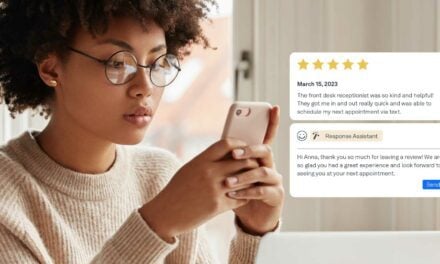New technologies and approaches can dramatically improve your closing ratio
 |
Are you frustrated about the cost of advertising and marketing to your patients and community? What about the time your staff spends with patients to remind them of appointments, in addition to handling paperwork and meeting with them? And then consider when you meet with a patient to discuss medical options, only to learn they decided to “think about it” and will call you when they are ready?
Although the prospective patient may call you days, weeks, or months later, do you feel like you’ve just wasted your time, your staff’s time, and your advertising budget, as well as hurt your employees’ morale?
What went wrong? Here’s a clue:
An aesthetic patient who is confused over procedures, technologies, and postoperative results will decide to do nothing.
You must regroup and take the initiative—educate your patients in simple-to-understand terms, and use educational tools to help them understand what they need to know so they move forward with the procedure or treatment.
Patient education plays a vital role in aesthetic medicine. Using everything available that helps you attract, educate, inform, and close more procedures makes good business sense.
At a recent open house of a plastic surgery practice, patients were encouraged to bring their friends, which they did. The event was beautifully catered, well attended, and professionally run.
In addition to the surgeon and his staff, several of the physician’s vendors were on hand to talk products and services with the attendees.
Many of the attendees were in the ideal target market for high-end surgical procedures, as well as minimally invasive procedures with high profit margins. The majority of the attendees were between 30 and 60 years of age and affluent, professional women.
CONFUSION REIGNS
You might assume that your attendees have “heard it all,” especially as the media bombards them with all kinds of information about current aesthetic enhancement procedures. However, the reality is that patients are not at all clear about your products and services, the procedures, and the after effects.
Typical questions and comments that might emerge during such an event:
“Isn’t Restylane the same as Botox?”
“I heard fat comes back in other, non-lipo’d places and you get all lumpy.”
“I heard you lose all sensation in your nipples when you get a boob job.”
“I didn’t realize I could do anything about the spots and veins on my hands.”
“I don’t want those big Hollywood lips.”
At one such gathering, a woman in her 60s told me that this was her third event in a year and she’s more confused than ever. She’s been to two consultations with different physicians, and one told her she needed the “whole enchilada”—meaning face/neck/eye/brow lifts. Also, she was overwhelmed by both the price as well as the after-surgery downtime (not to mention the fear of major surgery).
Another physician understood her apprehension about surgery, so he suggested wrinkle fillers and laser procedures. However, he confused her while explaining short- and long-term fillers versus facial volumizers, and skin tightening versus skin resurfacing. She was frustrated and felt defeated. She remained stuck in contemplation, wanting some type of rejuvenation but uncomfortable that she did not thoroughly understand the process.
If the majority of the aesthetic patients at this event were mature, educated, high-end women in a metropolitan city, how misinformed or confused is the less-traveled person who has never attended such an event?
EDUCATING THE PATIENT
This kind of confusion within the very target market you are trying to attract is not going to help your business succeed.
Even though the Internet can help disseminate information to potential patients, some of the information on the Web can be confusing and conflicting.
Finally, the ubiquitous reality-based television shows—such as Extreme Makeover, Nip/Tuck, and The Swan—romanticize and simplify aesthetic surgery so that the average mentality can grasp the subject. However, many people believe what they see and hear on television and only think they understand the procedures and the results.
Don’t get overwhelmed or disheartened. Your job has become easier because the stigma of aesthetic enhancement has decreased dramatically and, currently, patients are very willing to discuss it openly. On the other hand, be aware that the popular media’s interpretation of the aesthetic surgery industry has the potential to broadcast misinformation.
In such an environment, potential clients may come to you with an unrealistic view of how they will look and feel after surgery.
A well-informed patient saves you time, money, and effort. For example, if someone comes to a consultation armed with printouts from the Internet, that’s an indication of where to start your discussion.
By the way, a good question to ask the well-informed patient is, “I can see you are very knowledgeable about the procedure you are interested in. What else can I tell you or explain to help you reach a decision?”
With aesthetic medicine advancing so rapidly, it is almost impossible for your patients to keep up to date on the new technologies and procedures available to them. Also, they may not realize how easily these new procedures can be performed and with how little downtime.
You can benefit from offering potential patients all the educational tools at your disposal to steer them through the maze of aesthetic enhancement issues and lead them to a decision.
A side benefit you may enjoy from using educational tools is their marketing advantage. Typically, the physician who best educates the prospective patient is most likely to win their business. Best-case scenario: they feel confident that you understand them and will know how to address their concerns.
Use the best tools you can find to show them possible results, risks, and outcomes of surgery in a clear manner.
Physicians who incorporate patient education into their advertising and marketing strategies will gain a competitive edge—especially on the Internet.
If you have a Web site, offering online-based patient-education resources as a service or Web link will probably attract prospective patients from a wider geographic area.
The convenience and efficiency of online patient education enables new clients to move faster through the pipeline and closer to booking a consultation. Web surfers look for clear, understandable answers to their many questions; secondary to that is finding the best physician for the job.
The physician who provides the most straightforward information that is crafted in a creative and visual way will be seen as cutting-edge and credible.
VISUAL COMMUNICATION
Today’s aesthetic surgery customers are a cynical group. They don’t trust easily and want and need proof that what you say is what they will get. In addition, as we all know, aesthetic results are subjective.
Advanced educational tools help clear up some of that subjective confusion. Patients can perceive the possibilities better when visuals are used. Before they make a decision to get or not get whatever procedure is under consideration, they want to know they will be happy with the result.
Patients who are given the proper attention and educational tools are the ones you will be able to count on for repeat business and good word of mouth.
What’s Hot
Practice Video
Don’t skimp on this valuable addition to your marketing arsenal. The video should include scenes of you discussing your philosophies, introducing your staff, a tour of your office, and information about your products and services (including detail about the procedures that you offer). Send copies of your practice video DVD to prospective patients.
Online Patient Education
The latest tools to help educate aesthetic patients include ready-to-use presentations customized with your own voice and photos, as well as 3D interactive procedure animations that can run on a practice’s Web site. Because they are so visual and informative, online tools help you save time and can inform prospective patients.
Reception-Area DVD
There’s no better medium for patients to learn about a practice than video. A waiting-room DVD should be informative, enlightening, and patient-focused. It could be a version of your practice video. Decrease appointment no-shows by sending out this video to patients via mail.
Digital Photo Albums with Audio
Computer-based slide shows run your before-and-after photos on a continuous loop. You can add visual narration and background music to enhance the visual appeal.
Touch-Screen-based Patient Learning Center
Using this flexible technology, patients can control what they want to learn. They can learn about all of the procedures you perform.
Skin Analysis
There is nothing more compelling for a patient than seeing their own skin damage and aging process, as well as seeing the results after surgery. The more you can customize a problem and solution to that patient’s specific situation, the more likely that patient will decide on a procedure.
Computer Imaging
This helps you to clearly establish reasonable patient expectations. Using the patient’s own image to demonstrate potentials of aesthetic procedures, imaging can help establish natural, meaningful communication during consultations.
Full-Body Photography
New technology makes it possible to take full-body photographs rather than just shots of the face. This is helpful to patients with a need for surgical procedures below the neck.
On-Hold Messaging
On-hold messaging has been around for years. However, it is widely overlooked by busy practices. This technology can be used to relay useful information and prompt the caller to want to learn more.
Catherine Maley, MBA, is president and senior marketing strategist of Cosmetic Image Marketing in Sausalito, Calif. Her firm specializes in helping aesthetic practices grow using public relations, advertising, and strategic marketing. She can be reached at (877) 339-8833 or via her Web site, www.cosmeticimagemarketing.com.





